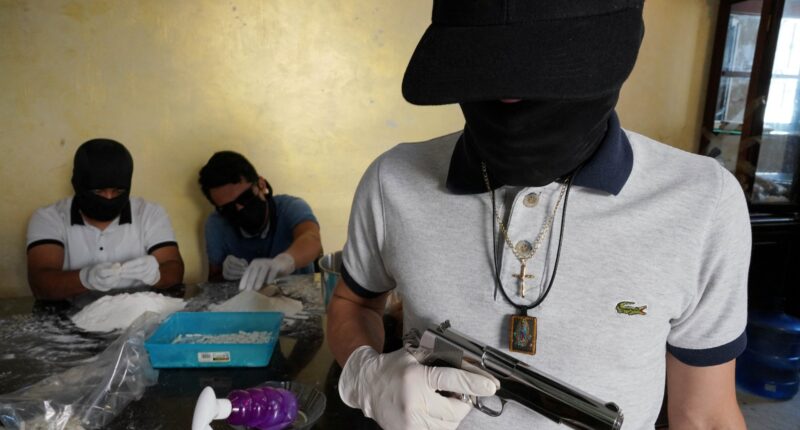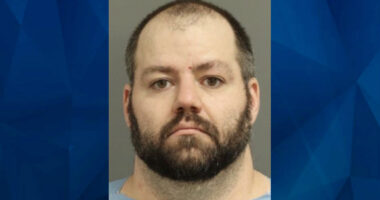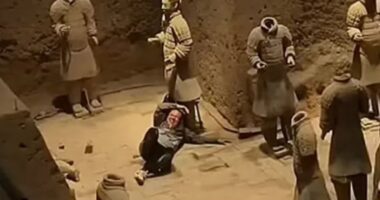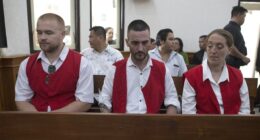THE names of ruthless drug kingpins conjure ghoulish images of vicious assassinations, burning cars, white powder, weapons and deadly machismo.
And now Donald Trump’s new government is set to wage a lethal war to crush the criminal cartels who pose a deadly threat to millions.



One of the first actions taken by the new US president was to designate criminal organizations from various countries as foreign terrorist groups. He specifically targeted gangs from Mexico, Colombia, Venezuela, and El Salvador and vowed to take aggressive measures to combat their activities.
As part of a series of executive orders issued shortly after taking office, the president emphasized the threat posed by these cartels to the safety of the American people, the security of the United States, and the overall stability in the Western Hemisphere.
The executive order highlighted the cartels’ history of violence and terrorism in the region, which has had a destabilizing impact on several countries of strategic importance to the US. Additionally, it pointed out the influx of dangerous drugs, violent offenders, and criminal elements into the United States as a direct result of the cartels’ activities.
So who are the biggest gangs Trump is cracking down on – and how have they built their blood-soaked empires?
‘Kill, rape, control’
Much of the most gruesome violence and bloodshed in the States itself is blamed on the powerful El Savadorian cartel Mara Salvatrucha, or MS-13, – known for their chilling motto ‘kill, rape, control.’
These cold-blooded killers employ a crude peasant tool, the machete, to rip into the bodies and psyches of anyone who dares defy them.
The gang first originated in Los Angeles with a group of impoverished boys who had fled to America from El Salvador as refugees from the country’s long-running and brutal civil war in the Eighties.
Other members soon followed from Honduras, Guatemala and Mexico with sinister nicknames such as Antichrist, Felon and Black Angel.
The MS in the name stands for Mara Salvatrucha, said to be a combination of Mara, meaning gang, Salva, for Salvador, and trucha, which translates roughly into street smarts.
The number 13 represents the position of M in the alphabet.
Now the brutal street gang is primarily involved in the distribution of cocaine, heroin, methamphetamine, fentanyl, cannabis and MDMA, and according to the FBI its reign of terror has spread to at least 46 states across the US.
MS-13 ramped up their violent campaign in 2017 when four men aged 16 to 20 were beaten to death with baseball bats and their bodies hacked to pieces with machetes.
Their corpses were dumped in a New York park.
“Make no mistake about it,” said the local county police commissioner at the time, “It’s a war.”
The massacre came seven months after the barbaric murders of two teenage girls in Brentwood.
Both were beaten to death in an ambush that involved MS-13 members, according to cops.
This violent criminal gang is now believed to have anywhere between 30,000 and 60,000 members spread across dozens of US states, at least six other countries in the Americas, Australia and several European countries too.


Their other vile crimes have also included the kidnap, torture and rape of a 14-year-old girl, held against her will for 18 days, and the murder of a second victim who was found shot at the side of the road in Texas.
Chillingly two MS-13 gang members laughed in court as they stood accused of killing her as a ‘soul sacrifice’ to the ‘Beast’ in a Satanic ritual after she insulted their demon god.
At one point during the girl’s horrific ordeal they crudely tattooed an image of the grim reaper on her leg.
In 2020 five gang members on a killing spree lured a 16-year-old girl, Gabriela Alejandra Gonzalez Ardon, to a park in Baltimore where she was murdered.


Her body was dumped in a nearby reservoir.
Asael Ezequie Gonzalez-Merlos, 16, Jonathan Pesquera-Puerto, 19, Wualter Hernandez-Orellana, 19, Edys O. Valenzuella-Rodriguez, 20, and Wilson Art Constanza-Galdomez, 21, were all charged with first degree murder.
In 2019 six other MS-13 gang members were charged with the murder of Daniel Alejandro Alvarado Cuellar in Maryland.
Cops said the 21-year-old victim was killed as part of the long-running war between MS-13 and rival Latino Street gang 18th Street.
The 18th street gang also have their roots in Los Angeles and like their rivals, have now spread across the US, Central and South America.



Members are forced to abide by a strict set of rules.
Failure to obey the word of a gang leader, or to show proper respect to a fellow gang member may result in an 18-second beating, or even execution for more serious offences.
MS-13 has been accused of recruiting poor, vulnerable and at-risk teenagers.
Joining requires being “jumped in” or subjected to a vicious 13-second beating, and “getting wet” – carrying out a crime, often a murder, for the gang.
Leaving is potentially even more dangerous.
Large chest tattoos brand members for life, and some factions are said to murder members who dare to attempt to leave.

The sons of El Chapo
More than 450,000 people have been murdered across Mexico since the country launched a major offensive against its powerful drug cartels in 2006.
The staggeringly high death toll, as well as the disappearance of tens of thousands of others, has been laid firmly at the feet of organised crime cartels.
The most influential gang, the Sinaloa Cartel, continues to wreak havoc.
In October last year Mexican mayor Alejandro Arcos, 43, was beheaded just six days after taking office in a brutal assassination.
His severed head was prominently displayed on the roof of a car, while the rest of his decapitated body was left slumped in the passenger’s seat.



The barbaric killing, which has shocked Mexico, came just three days after the secretary of the same city council was also killed.
The two murders were just the latest in Gurrero state where there were 1,900 murders last year and six political candidates were slain ahead of this year’s elections.
Guerrero is one of the worst states affected by cartel violence due to its location on the Pacific coast smuggling routes.
The state is also home to the former popular holiday hotspot Acapulco.
The once thriving tourist town is now among the most violent places in the world, with the second highest murder rate in Mexico.


Another mayor from the same state elected last June was also killed when he was shot dead while driving on a motorway.
The state has long been a stronghold of one of Mexico’s most infamous war lords El Chapo, who is currently behind bars in the US, and his sons.
In August last year when Ivan, one of El Chapo’s 25 sons, was thought to have been arrested, yet more violence flared as gang members took on the army.
Buses and trucks were set alight amid the fighting.
A military patrol on the outskirts of the city was attacked by gunmen while roadblocks – known as narco-blockades – were put in place.
The city had already been troubled by tension following the arrests of kingpin Ismael “El Mayo” Zambada and Joaquin Gozman Lopez – one of El Chapo’s other sons – in July.



In 2019, a fierce conflict dubbed The Battle Of Culiacan erupted as authorities swooped on Ivan’s half-brother Ovidio Guzman Lopez.
A convoy of cops and soldiers stormed Ovidio’s home before hundreds of cartel members began causing chaos, leaving the city like a war zone, with fires raging and crumpled bodies strewn across the road.
The bloody gun battle was the result of an attempt by the police to arrest a suspected cocaine kingpin — only to have his gang turn the tables on them – showing the extreme lengths the Sinaloa cartel will go to in protecting the sons of ruthless El Chapo.
Since he was jailed five years ago rival factions have constantly battled for power in his absence.

Also fighting for supremacy in Mexico is the Gulf Cartel, the oldest organised crime group in the country, based directly across the US border from Brownsville, Texas.
The network is connected to gangs across Europe, Africa and the US.
Besides drug trafficking, the Gulf Cartel also operates countless protection rackets, assassinations, extortions, kidnappings and other criminal activities.
Members of the Gulf Cartel are known for intimidating the population and for being particularly violent.
They drive around in Mad Max-style monster trucks equipped with battering rams, four-inch-thick steel plates and turrets for machine guns to take on law enforcement and rival mobs.
Known by Mexican law enforcement as narco-tanks, rhino trucks or simply monstruos – meaning monster – they are often painted in camouflage patterns and emblazoned with the cartel’s initials.
The trucks are the latest additions to the cartels’ high tech arsenals unleashing bloody mayhem on the cocaine trail.



The Tijuana Cartel was once described as ‘one of the biggest and most violent criminal groups in Mexico’, although it was weakened in 2006 when its chief Javier Arellano Feliz was arrested by the US Coast Guard as a result of an operation to root out corrupt cops who were cooperating with the Cartel.
Colombia’s increasingly sophisticated cartels, which also include the Jalisco, Northeast, La Familiar and Juarez, all appear to follow the same basic structure.
The falcons are the lowest ranking members, the eyes and ears on the streets.
Hitmen are the armed group responsible for carrying out assassinations, kidnappings, thefts and extortions, operating protection rackets, as well as defending their turf from rival gangs and the military.
Lieutenants supervise the hitmen and falcons, and are allowed to carry out low-profile murders without permission from their bosses.
Drug lords hold the highest position in any cartel, responsible for supervising the entire drug industry, appointing territorial leaders, making alliances, and planning high-profile murders.

Colombia’s Paramilitary
For years Colombia has been home to the well-known Medellín, Cali, Norte del Valle, and North Coast Cartels who would surely make Trump’s list of targets.
But the terrifying paramilitary group Clan del Golfo is currently the country’s largest drug cartel.
Bloodythirsty leader Daniel Rendon Herrera heads up the powerful criminal organisation, which recruits its members mainly from former right-wing paramilitaries and is said to have an army of around 6,000 spread across 12 of Colombia’s 32 regions.
In addition to drug trafficking, the Gulf clan is also involved in illegal mining and racketeering.



The feared cartel is believed to have close ties to the mafia in a ‘supergang’ drugs partnership, which was allegedly behind a record 4.3 tonne haul of cocaine worth more than £200million seized in Italy in 2022.
The cocaine was reportedly smuggled into Europe by the Clan del Golfo cartel, who are believed to be the biggest smugglers of the drug in the world.
Police also confiscated around £1.58million in cash.
It came as a further blow, following the arrest of leader Dairo Antonio Usuga David, also known as Otoniel.
He was extradited to the US following a dramatic jungle raid branded the most significant since the fall of Pablo Escobar.
In 2021, UK and US intelligence, working alongside their Colombian counterparts, had tracked down Otoniel in his jungle hideout.
He was reportedly found hiding half-naked in foliage by soldiers.
As well as being accused of sending dozens of shipments of cocaine to the United States, he was also charged with murdering police officers, sexually abusing children, and recruiting minors to his bloodthirsty cartel.
More than 500 Colombian special forces and soldiers entered the jungle, surrounding the drug kingpin’s lair and bypassing eight different rings of security before capturing the infamous criminal.
Colombia’s president hailed it as the biggest blow against the drugs trade in 20 years – although the country still remains the world’s biggest producer of cocaine.
And less than a year later the clan fought back – enforcing a four day ‘armed strike’ across the country, imposing strict lockdowns and warning residents to stay inside or risk being shot or having their vehicles burnt.
Families and hospitals ran out of basic supplies, and during the course of the strike the Gulf Clan committed at least 309 acts of violence, 24 people were killed and a further 15 attempted murders were recorded.
Venezuela’s tentacles
The notorious Venezuelan gang Tren de Aragua has spread its tentacles across the US and is now said to be terrorising major cities across North America.
Local officials say the deadly cartel, known primarily for trafficking women, are running operations in the southern state.
Cities in Illinois, Connecticut, Georgia, New York, Colorado and Texas have also endured incidents involving the gang.
Members had been abducting women from Venezuela and taking them to the States where they were forced into sex work.



They have such a hold over the country that local pockets have control over all aspects of life, including schools, justice and even the way residents are allowed to paint and decorate the front of their homes.
For years the group’s leadership were masterminding operations out of the notorious Tocorón prison, which they controlled and turned into a mini city for themselves.
Incredibly, in 2023, 11,000 cops stormed the prison walls where they discovered a casino, nightclub and even a zoo inside.
Bizarre body cam footage from the dramatic raid showed flamingos in a dirty pond, and a wildlife park that was home to leopards, tigers, lions, crocodiles and pumas.
Members of the gang also enjoyed their own nightclub and several restaurants, where inmates could eat and party with visitors.
Cops found a swimming pool next to a play area for children, and a baseball field.
Inmates also enjoyed gambling in a makeshift casino and illegally mined cryptocurrency in the mini city.
Officials also found a cache of weapons, including automatic rifles, machine guns and thousands of rounds of ammunition.
But hundreds of inmates escaped via a network of secret underground tunnels.
US Border Patrol chief Jason Owens, posted on X: ‘Watch out for this gang. It is the most powerful in Venezuela, known for murder, drug trafficking, sex crimes, extortion, & other violent acts.’

















